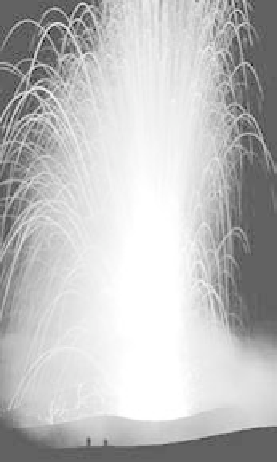Geoscience Reference
In-Depth Information
Although hidden from our direct view by thousands of
meters of ocean, these contribute by far the most voluminous
proportion of volcanic products to the surface each
year. The overall proportion of acid : intermediate : basic
volcanics erupted each year is about 12 : 26 : 62 percent.
Despite the obvious surface manifestations of volcanic
activity, the majority of melt (around 90 percent)
generated in the mantle and crust remains below surface
forming slow-cooled
plutonic igneous rock
in the form of
masses called
plutons
. Some is squirted from consolidating
plutons into vertical or subvertical cracks as
dykes
, or
nearer the surface as horizontal
sills
, both of which may
feed surface volcanoes. Plutons, dykes, and sills are very
common in the upper crust, as seen in deeply eroded
mountainous terranes like the Andes or Rockies. We
would like to know why such large volumes of former melt
remain below the surface.
5.1.2
Melting processes
We have seen in our consideration of the states of matter
(Section 3.4) that thermal systems transfer energy by
changing the temperature or phase of an adjacent system
or by doing mechanical work on their local environment.
For melting to occur, a solid phase may be converted to a
liquid by (1) application of temperature or pressure, (2)
temperature retention with only minor heat loss due to
work done by internal energy on expansion during adia-
batic ascent, and (3) reduction in local melting point by
addition of aqueous or volatile fluxes. We further amplify
these reasons below.
Concerning heat energy, a certain amount, the latent
heat of fusion,
L
f
(Section 3.4), is needed to melt crys-
talline rock. This amount can be measured in a calorimeter
apparatus by comparing the heat released on melting
silicate crystals or rock with amorphous silicate glass of
Fig. 5.4
Typical nightime view of Stromboli fire fountain erupting
from vent three, May 1979. Note parabolic ballistic trajectories of
volcanic ejecta. Two Figures silhouetted for scale.
(a)
(b)
(c)
ol
fp
qz
fp
px
ol
px
px
qz
fp
Granite with coarse equant
crystals of clear quartz (qz) and
shaded alkali feldspars (the
laminae in the latter are twin
planes or compositional layers)
Andesite lava showing well-
developed phenocrysts of feldspar
(fp) and pyroxenes (px) set in a
very finely crystalline to glassy
groundmass
Two half-views of olivine basalts,
with well-developed phenocrysts
of olivine (ol) and lath-like feldspars
set in finely crystalline to glassy
groundmass
Fig. 5.5
Sketches of microscopic fabric (fields of view about 5 mm diameter) and mineral phases of common igneous rocks that have
crystallized from cooling melts.























Search WWH ::

Custom Search